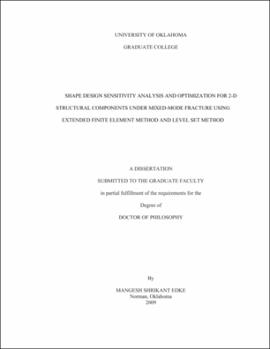| dc.contributor.advisor | Chang, Kuang-Hua | |
| dc.creator | Edke, Mangesh Shrikant | |
| dc.date.accessioned | 2019-04-27T21:32:09Z | |
| dc.date.available | 2019-04-27T21:32:09Z | |
| dc.date.issued | 2009 | |
| dc.identifier | 99277447702042 | |
| dc.identifier.uri | https://hdl.handle.net/11244/318932 | |
| dc.description.abstract | Weight and service life are often the two most important considerations in the design of structural components. This research incorporates a novel crack propagation analysis technique into shape optimization framework to support design of 2-D structural components under mixed-mode fracture for: (i) maximum service life subject to an upper limit on weight, and (ii) minimum weight subject to specified minimum service life. In both cases, structural performance measures are selected as constraints and CAD dimensions are employed as shape design variables. Fracture parameters, such as crack growth rate and crack growth direction are computed using extended finite element method (XFEM) and level set method (LSM). | |
| dc.description.abstract | XFEM is a computational technique in which special enrichment functions are used to incorporate the discontinuity of structural responses caused by crack surfaces and crack tip fields into finite element approximation. The LSM employs level set functions to track the crack during the crack propagation analysis. As a result, this method does not require highly refined mesh around the crack tip nor re-mesh to conform to the geometric shape of the crack when it propagates, which makes the method extremely attractive for crack propagation analysis. | |
| dc.description.abstract | However, shape sensitivity analysis for crack propagation involves calculating derivatives of enrichment functions employed in XFEM that are discontinuous or unsmooth. The proposed sensitivity analysis method in this study overcomes these issues and calculates accurate derivatives of both crack growth rate and direction with respect to design variables. The proposed method employs (i) semi-analytical method for the derivatives of stresses and displacements, and (ii) material derivatives for the SIFs obtained from the domain form of the interaction integral, and therefore, the crack growth rate and direction. The method enables computation of sensitivity coefficients of fracture parameters for a growing crack and is up to 40% faster than the commonly used finite-difference method. | |
| dc.description.abstract | Two different optimization approaches--a batch-mode, gradient-based, nonlinear optimization and an interactive what-if analysis--are used for optimization. An engine connecting rod example is used to demonstrate the feasibility and accuracy of the proposed method. The design optimization process can successfully handle arbitrary 2-D geometries and can solve general design problems that are most commonly encountered, such as design for maximum life and design for minimum weight. | |
| dc.format.extent | 139 pages | |
| dc.format.medium | application.pdf | |
| dc.language | en_US | |
| dc.relation.requires | Adobe Acrobat Reader | |
| dc.subject | Structural optimization | |
| dc.subject | Production engineering | |
| dc.subject | Finite element method | |
| dc.title | SHAPE DESIGN SENSITIVITY ANALYSIS AND OPTIMIZATION FOR 2-D STRUCTURAL COMPONENTS UNDER MIXED MODE FRACTURE USING EXTENDED FINITE ELEMENT METHOD AND LEVEL SET METHOD | |
| dc.type | text | |
| dc.type | document | |
| dc.thesis.degree | Ph.D. | |
| ou.group | College of Engineering::School of Aerospace and Mechanical Engineering | |
